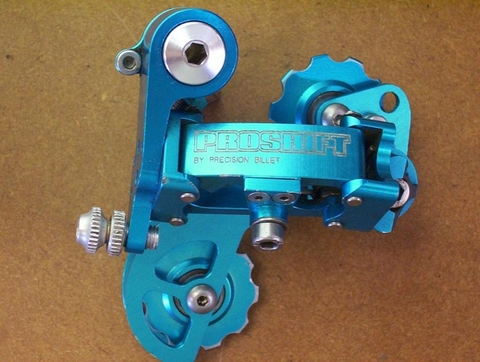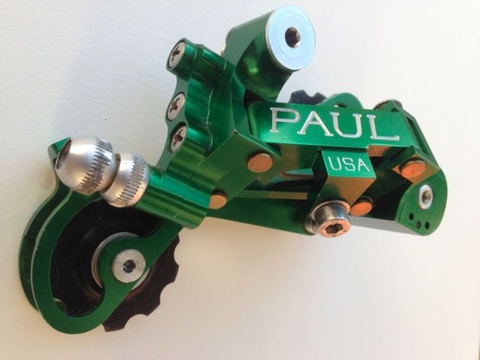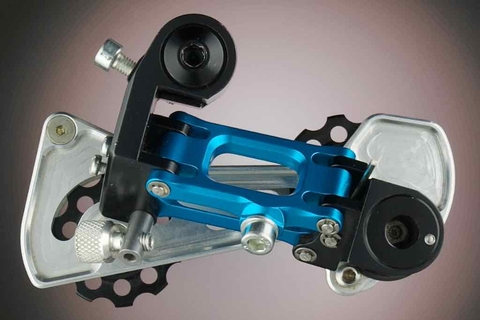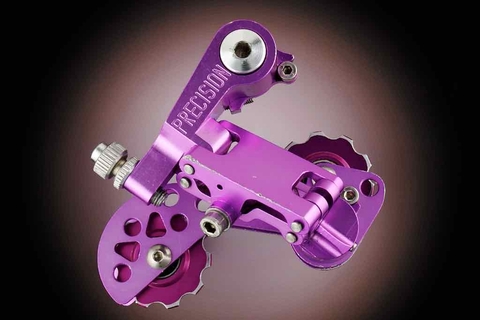Table of Contents
Changing Gears
Riding off-road demands quick changes across a wide selection of gears. The complex machinery of derailleurs and shifters has gone through continual growth, much of which has been driven by mountain biking. Elsewhere, mtbtimeline already has a components page created to help date 80's bikes by their derailleurs. This page addresses a full century's worth of changing gears, from the to birth of derailleurs to Rapidfire to bump stoppers.
For the first 50 years cyclists suffered without gearing, consigned to riding fixies on level surfaces at restrained speeds. In 1884 freewheels appeared, followed by derailleurs in 1899. After many excellent derailleurs became popular, it wouldn't be until 1937 that the Tour de France embraced derailleurs and the technology became truly mainstream.
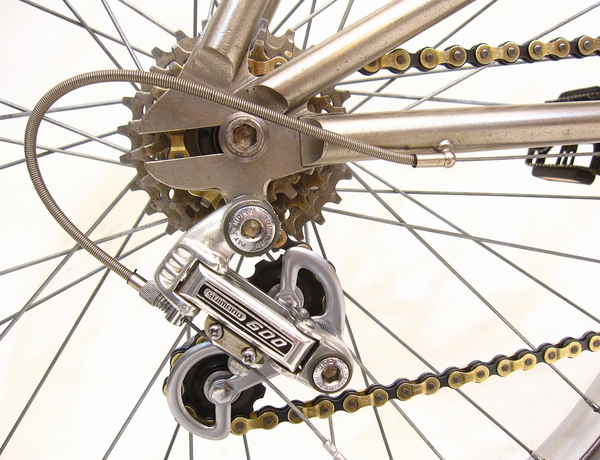
Shimano 600 GS (capacity: 34) on a 1978 Breezer Series I
vintagemtbworkshop
Most 1970's mtbs used either the Shimano 600 or the Simplex SLJ6000.
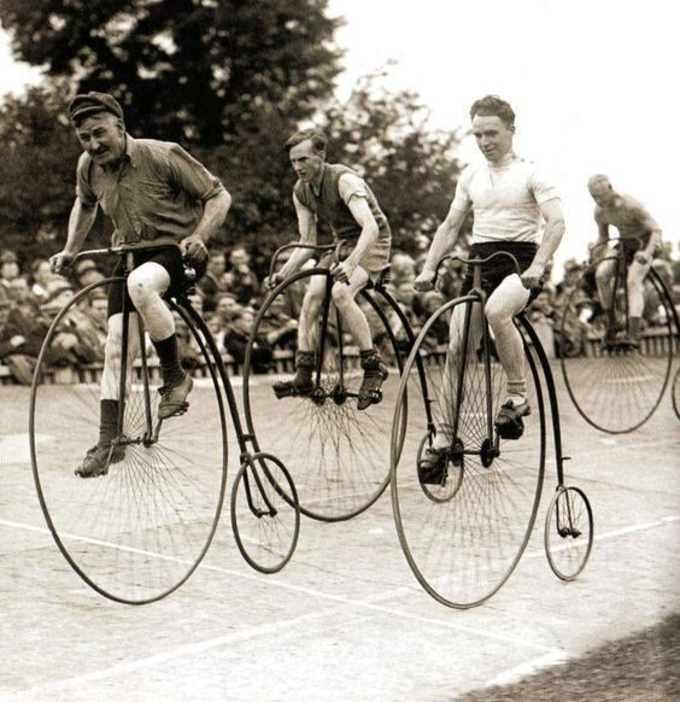
Penny farthing race Herne-Hill, London, July 1, 1932
pinterest
With the first penny -farthing bicycles, the higher the wheel, the higher the top speed, so that racers would often have wheels as tall as 60 inches. That is, if their legs were long enough to straddle the tires and reach the pedals.1) Bicycle gearing today is often measured in terms of the height of an equivalent penny farthing bicycle and are called gear inches.
By 1899, lever operated, simple derailleurs became available, and were good for two rear gears on a safety bike with suspension, freewheel and rim brakes.
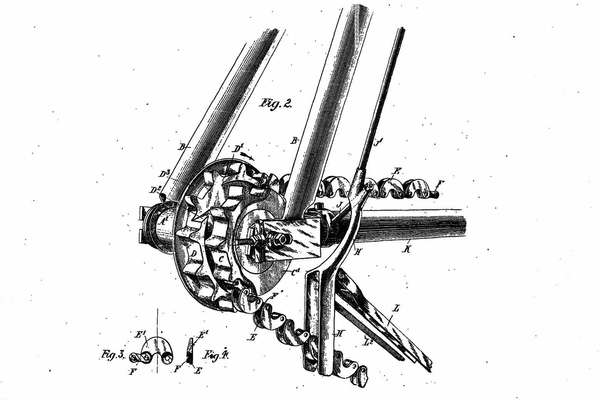
1899 New Protean derailleur.
disraeli
Obviously, the chain was crap. No plans on making a timeline for chains, as long as Sheldon Brown's website remains running.
The first useful handlebar operated, rear derailleur became popular circa 1920 with the Chemineau (usually 2×3 speeds), followed in 1937 by the Nivex parallelogram rear derailleur (4 speeds, often with a front double or triple,) which worked nearly flawlessly.2)
The organiser of the Tour de France, Henri Desgrange, dismissed [derailleurs] in L'Auto as fit only for invalids and women. wikipedia
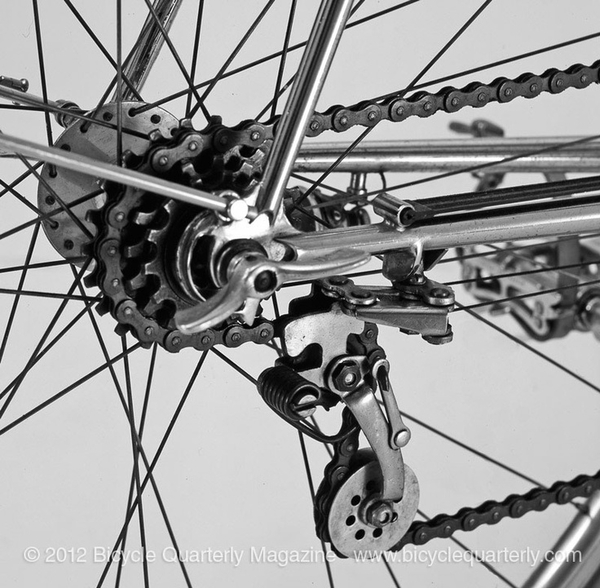
1938 Nivex renehersecycles
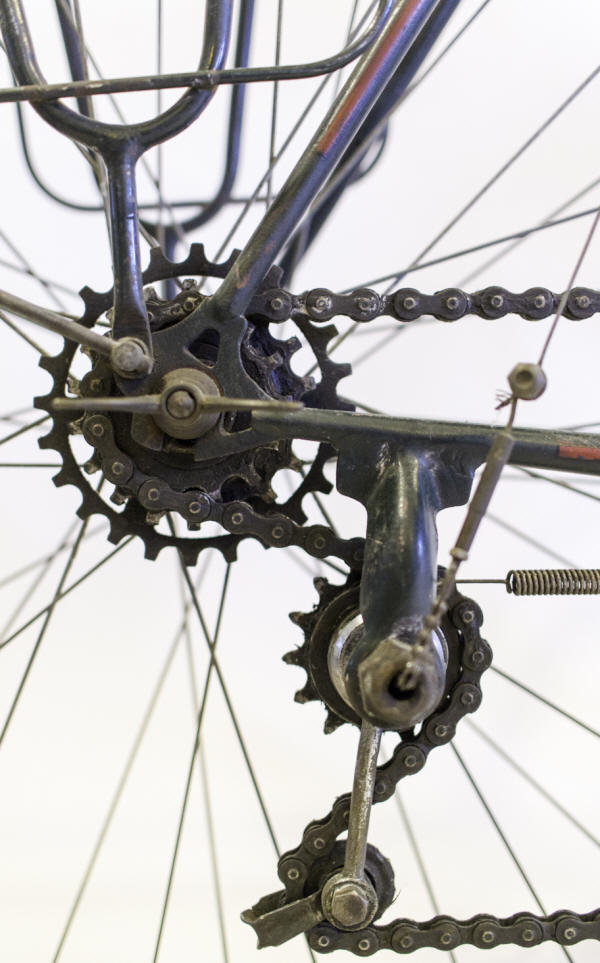
The Chemineau disraeli
The first practical derailleur, ca. 1920, Developed by Joanny Panel
Mountain Derailleurs
The first mtb builders used touring derailleurs for their wide ranges. They were not particularly robust: prone to clogging, misalignment and simply snapping under the punishment which mtbs endure. Creating light weight, strong, performant and affordable mountain derailleurs continues to drive development today.
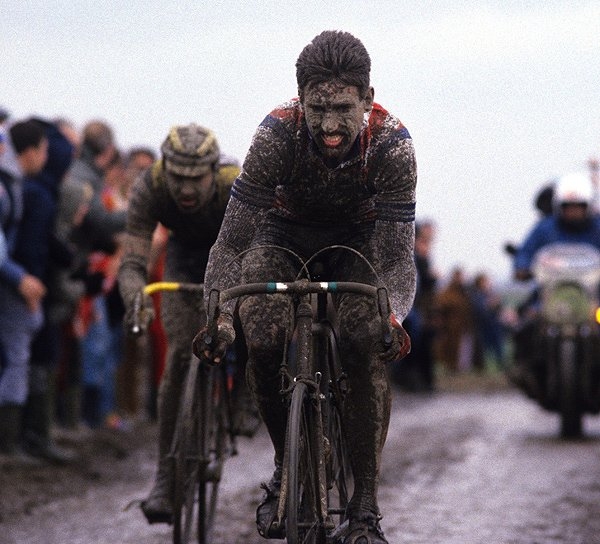
Road riders get muddy too.
Sean Kelly, 1984 Paris-Roubaix
photo by Graham Watson
twitter
1982 SunTour MounTech GTL
The SunTour MounTech was the first derailleur ever designed specifically for use on a mountain bike. Truly a milestone product. …
When this derailleur appeared it was considered to be the epitome of sophistication - a wonder to behold. When Frank Berto first tested it he declared it the best changing gear he had ever tested. disraeligears
However, it was prone to getting clogged and “had a tendency to throw itself recklessly into the spokes of the back wheel.”3)
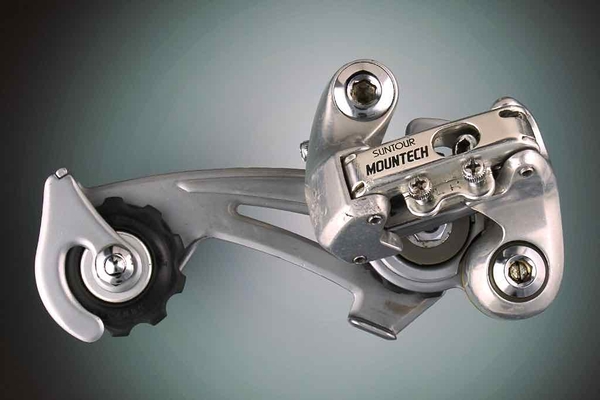
1982 SunTour MounTech GTL, 38T capacity,
disraeli
1982 Shimano Deore XT
Here it is: the first bullet proof, off road derailleur. Just as SunTour was losing its quality touch, Shimano pounced and took over the market with “a well-made, simple, strong gear.”4)
Shimano states in a video that XT was available in 1982, but the consensus is that is wasn't generally available until January 1983. However, the December 1982 Ritchey ads show some XT components.
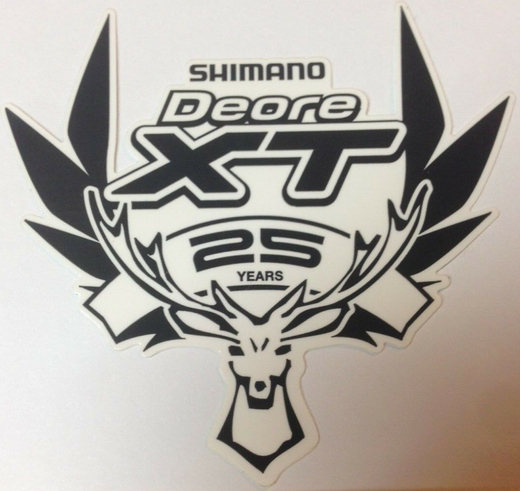
Shimano XT decal from 2007. ebay
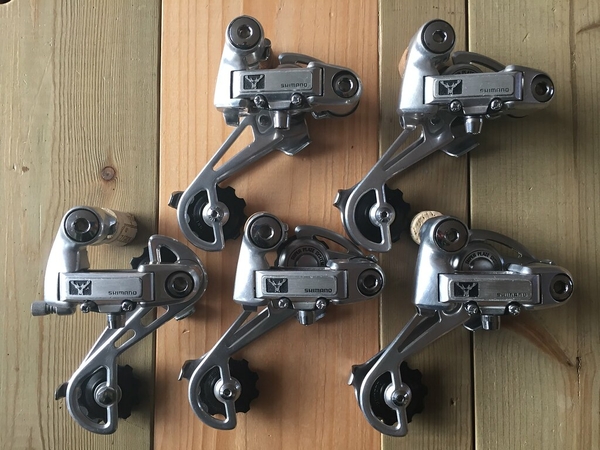
1984-5 variations of the Shimano Deore XT RD-M700, 40T capacity
bikeforums
5)
1991 Campagnolo Record OR
The Record OR was Campagnolo's ultimate and last attempt to dominate the high end mountain bike component market. They had previous created a decent 38T Euclid component group in a far too late bid to capture the hearts of the off road crowd. After the Record OR, Campagnolo returned to making pretty things for the Lycra set.
Record OR was fiendishly expensive, not particularly lightweight, did not index particularly accurately and so did not sell too well - in other words it had everything that a groupset requires to become a cult among vintage mountain bike fanatics today. disraeligears
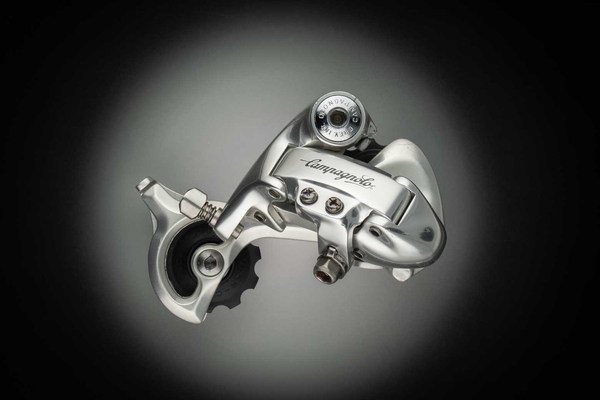
Campagnolo Record OR (RD-22OR 1st style) disraeli
1991 Shimano XTR
At the same time that Campagnolo saw some space above XT in the mtb market, Shimano dropped their Race version of the XT groupset; the first with integrated shifters with brakes and rapidfire triggers. It has remained the top end of mountain bike components: the Dura-Ace of mtb gruppos.6)
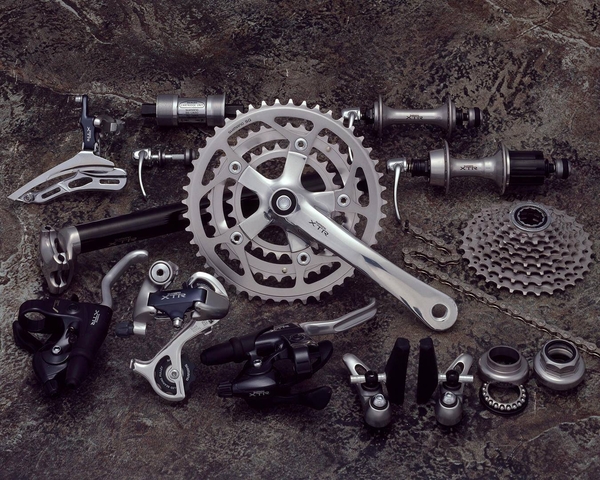
RD-M900 1992 Shimano XTR groupset, Shimano Facebook
1995 Paul Components Powerglide 'Rasta'
The CNC era was a beautiful time to be a mtb derailleur. Never since have so many many small component makers flourished.
“…water in the desert for mountain bike aficionados drowning in a sea of lookalike Shimano.”7)
Today, sadly, there are no pretty derailleurs left. Perhaps because they are fiendishly difficult to create and there exists an impenetrable wall of patents guarding any attempts to improve upon them. Or perhaps because of the association day-glo derailleurs have with being difficult, pricey and fragile? 8) But we've lost some playfulness and freedom by accepting corporate conformance. It's time to bring bling back.
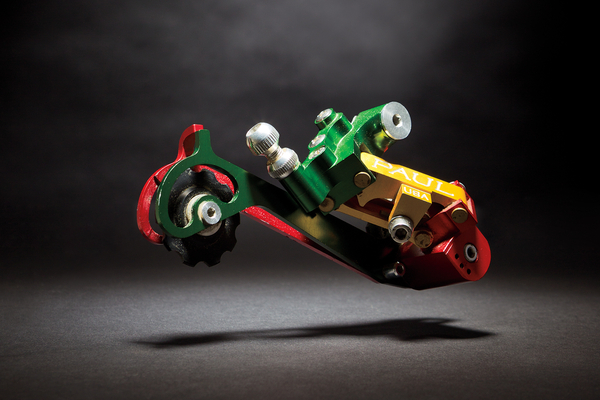
1995 Paul Powerglide bikemag
SRAM Grip Shift
SRAM started as a maker of Grip Shift in 1987, a twist shift system for triathletes' aero bars. Branching out to mountain bike downhillers, whose glove were probably too fat for Rapidfire, they signed Greg Herbold in 1990 and SRAM found it's niche in between the heavyweight component manufacturers. After 7 years of making just Grip Shifts, SRAM came out with a full component set.
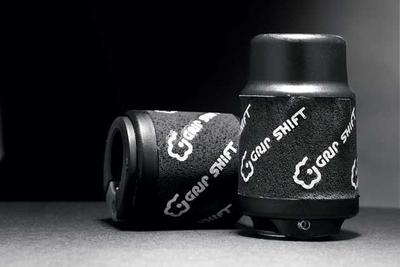 1988 SRAM Grip Shift bikemag
1988 SRAM Grip Shift bikemag
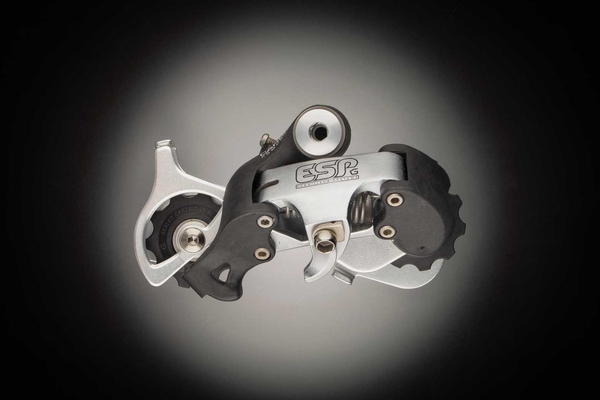
1994 SRAM EXP 900, 1st gen, their first rear derailleur
disraeli
The real significance of SRAM is that they exist at all. And that they've thrived. In the past 25 years SRAM has acquired Sachs, RockShox, Avid, TruVativ, Zipp, Quarq, Powertap, Time & Hammerhead. SRAM's 2020 revenues were $974M, while the Shimano Bike division reached $4B. Recently SRAM has surpassed Shimano in the high end mtb market. They won their market share by innovating faster than Shimano, introducing carbon drivetrain components, larger cassettes with 1x drivetrains, local race sponsorships, lighter weights, compatibility, suspension systems integration, acquisitions and simply being better at giving riders what they want.9)
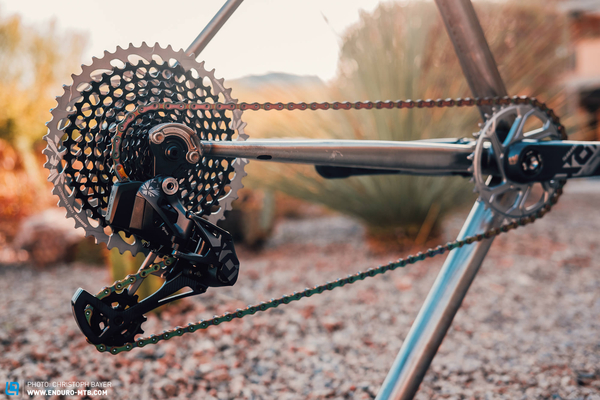
SRAM XX1 Eagle AXS enduro-mtb
equipped with bluetooth and an app
BTW, this is not mounted on a bicycle…
Indexed Shifting
As with suspension, disc brakes and shock absorbers, index shifting was common on kids bikes in the late 1960's in the form of stick shifts mimicking automobile transmission levers.10)
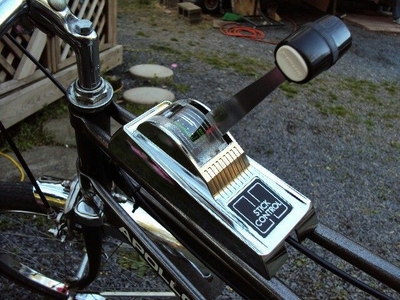
Shimano 5 speed derailleur indexed stick shift
pinterest
From kid's shifters & derailleurs indexing slowly improved:
- 1967 Shimano W series indexed grip shifters
- 1971 Simplex “click-shift”
- 1974 Shimano Positron
- 1975 Bridgestone Synchro Memory Shift
- 1980 SunTour Mighty Click
And then, in 1985, Shimano's SIS11) system arrived12) and destroyed all the competition. 13)
Shimano introduced Rapid Fire in 1989 as part of the Deore XT mountain group and remains with us today.
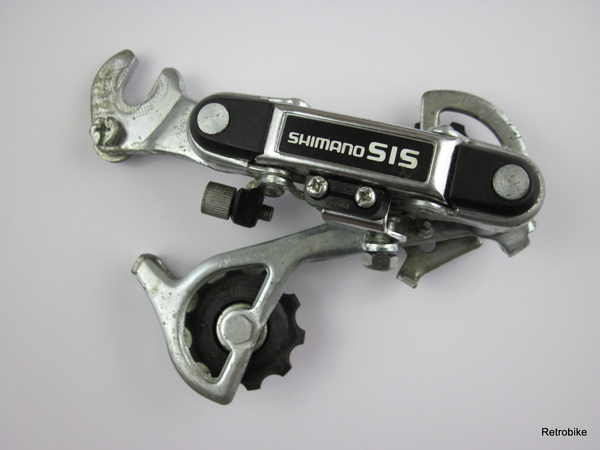
1993 Shimano Tourney RD-TY20-GS
retrobike
A Note on Compatibility
One of the great advantages of index shifting, at as far as the manufacturers were concerned, is that it locked you into a brand. Shifters and derailleurs had to be paired along brands.
Despite what JTek promises, the various brands, and generations of brands, are hopelessly incompatible.14) It's mostly down to cable pull: the millimeters of cable each click of a shifter pull & release. Sometimes it's linear, or gradually increases, or fluctuates from large to small to large again. See sample graph to the right →
The best solution is to stick to the same brand, or else study the compatibility charts carefully.
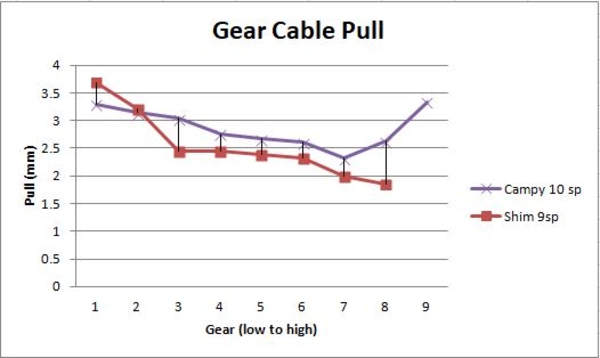
Cable pull chart bikeforums
Internal Hubs and Gearboxes
For most of the 20th century, the British eschewed derailleurs in favor of internally geared hubs for their cleaner aesthetic. With modern derailleurs getting more complicated, it's no wonder that today internal hubs, such as Rohloff's are making a comeback and that all other derailleurs only come in a single color: black.15)
Sturmey Archer has been making internal gear hubs since 1902 and today we have a number of companies, from Rohloff to Pinion who would have you believe that they have the mountain bike solution to end the reign of derailleurs. Both Rohloff and Pinion have a good gear range. Both are durable and low maintenance, until they aren't.16) The problems are:
- cost : Rohloff := $1700, Pinion := $6000
- weight : about 2 → 4 pounds extra
- wheel and/or frame changes (Pinion requires a special frame)
- lack of customization : no swapping ring sizes, etc.
- fewer gears : Rohloff has 14, Pinion has 18, Shimano XT Touring has 36
Yet there are plenty of advantages such as cleaner looks, apparent simplicity, weatherproof, … ? Until they show up on World Cup podiums, this timeline will ignore this tech.
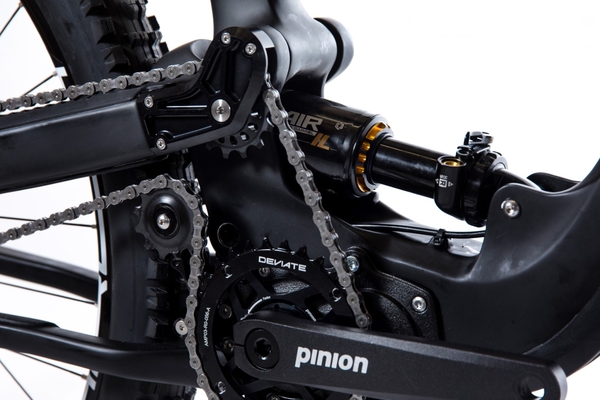
Pinion P-Line gearbox singletracks
New tech
To be finished…
Should include:
- rapidfire : under bar shifting
- clutches : chain stabilizing tension derailleur clutch
- bump stoppers : a Shimano effort to quiet bouncing derailleurs
- electronic shifting : incl. wireless
- integrated shifters : brakes and shifting merged - more of a road advantage
- 1x systems : giant cassettes to the rescue
- belt and direct drives : not really a plus
- more?

